Are You Ready to Join the Slow Education Movement?
 Slow. I love this word, and yet it tends to have many negative connotations in education. Which is too bad because it’s the very philosophy we need to save our education system, and give kids the time and space necessary to grow into the thoughtful, articulate citizens we desperately need them to become.
Slow. I love this word, and yet it tends to have many negative connotations in education. Which is too bad because it’s the very philosophy we need to save our education system, and give kids the time and space necessary to grow into the thoughtful, articulate citizens we desperately need them to become.
The 20th Century was known for many things. Mass destruction, of course. Statistics show we managed to destroy each other and plunder the planet at a rate unequalled by any other century in history. The 20th Century was also a time of great exploration, innovation and technological advance. The exploration of space. The eradication of disabling and fatal diseases. Increased global awareness. A measure of equality for at least some groups who have been historically disenfranchised.
But the thing that stands out most vividly to me about the 20th Century is the emergence of what Canadian journalist Carl Honoré describes as “the cult of speed.” As speed has become an absolute good in the eyes of many, slow ways of life have largely disappeared. Many see them as ancient, naive, or largely impractical.
Instead, we live in an instant world, where most often if you ask someone how they are, the reply is busy, as if that response alone justifies one’s existence on the planet. Few people stop to ask if what we’re so busy doing is actually worth the energy we’re expending.
According to Honoré, fast and slow “are shorthand for ways of being, or philosophies of life.”
Fast is busy, controlling, aggressive, hurried, analytical, stressed, superficial, impatient, active, quantity-over-quality.Slow is the opposite: calm, careful, receptive, still, intuitive, unhurried, patient, reflective, quality-over-quantity. It is about making real and meaningful connections with people — culture, work, food, everything.
Unfortunately, our education system, at least in North America, has been deeply influenced by the “need for speed”, or what sociologist George Ritzer has termed “McDonaldization” – that is, “the process by which the principles of the fast food industry are coming to dominate more and more sectors of the world.”
Ritzer outlines four characteristics of this mechanistic worldview: efficiency, predictability, calculability (quantifiable results) and control – or at least the illusion of control.
The fast school system
In education, McDonaldization attempts to wipe out any of the messiness or inefficiencies of learning. Instead, it attempts to reduce it to a commodity that can be packaged, marketed and sold. Rather than cultivating a deep, holistic love of learning that touches every aspect of a student’s life, learning is reduced to an assembly line. As we allow this to happen, we impose a mechanistic view of learning (which, in nature, is largely an organic process) and at a great cost.
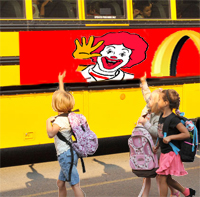 Our education systems continue to rapidly adopt short-cuts that reflect the dimensions of McDonaldization. Essentially, this imposition seeks the most efficient (read: easiest and cheapest) way to get a student from kindergarten to grade 12. In an assembly line, things are homogenized as much as possible. In education, we tend to see this in the assumption that the most important thing a group of kids have in common is the year they are born.
Our education systems continue to rapidly adopt short-cuts that reflect the dimensions of McDonaldization. Essentially, this imposition seeks the most efficient (read: easiest and cheapest) way to get a student from kindergarten to grade 12. In an assembly line, things are homogenized as much as possible. In education, we tend to see this in the assumption that the most important thing a group of kids have in common is the year they are born.
Efficiency has also the birthed the idea that educators can be better utilized by coupling them with online services like Khan Academy, somehow justifying the ridiculous class sizes that many teachers now have to deal with. I don’t doubt that the Khan Academy can transmit information, but can it help to develop our children into thoughtful , ethical citizens, who can critically evaluate, rather than being swayed by the flavor of the day?
Does this cut-to-the-chase strategy create better citizens or compliant consumers? When learning is treated as one more product to be consumed, a horrible disconnect occurs in our students. It becomes about the mark or grade point average. It becomes about the diploma. It becomes about the end justifying a lot of terrible means.
And if a student is not quite ready to read when reading is “introduced,” if they mess with the efficiency and control of the system, then they often pay the price for being “too slow” throughout rest of their lives. Kids are labelled as being not “academic,” as if being academic is the most important quality a child can possess. Creativity is quashed. Curiosity is quelled. Disengagement is rampant.
The desire for predictability produces the one-size-fits-all curriculum and the one-way-works-for-everybody instructional model. Every student will display the same skill (or regurgitation of content knowledge) at the same time. To calculate if any of this is making a difference, a system of high stakes testing is introduced. If students fail, the system is seldom questioned – it’s the fault of poor implementation, inadequate teaching or impaired learners.
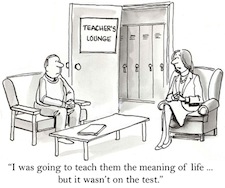 In some schools, of course, test scores are up (whatever that means). But at what price? Our students are increasingly stressed and disengaged from their learning. They can jump through the hoops, but most have little idea what they’re passionate about, beyond mindless distractions. How would they know?
In some schools, of course, test scores are up (whatever that means). But at what price? Our students are increasingly stressed and disengaged from their learning. They can jump through the hoops, but most have little idea what they’re passionate about, beyond mindless distractions. How would they know?
It’s not clear what the long term costs of all of these methods will be, but many teachers would agree that they will be dire. What does it do to a child to spend 12 years stressed out by tests or not measuring up to an arbitrary standard that’s largely unrelated to the way the human mind functions?
If educators and parents sense that something is wrong, why do they continue to support such a system? Fear. Fear of losing one’s job. Fear of losing funding. Fear of embarrassing test results being published. Fear of one’s child not being able to get into college and land a “good” job.
There’s an awful lot of fear in education today, and the truth is, we have no idea what the long term cost of this fearful environment will be. We know in the short term, we lose a lot of new teachers in the first five years. We know that others quit early or need stress leave. We know that many are dispirited and cannot hide this from their students.
So how do we change all of this insanity?
Enter the slow education movement
For awhile now, I’ve been researching and thinking deeply about the idea of slow education. The slow food movement is a grass roots concept that began in 1989 in Italy. Over the past 25 years, it has branched out to other areas of life that have been co-opted by speed and efficiency.
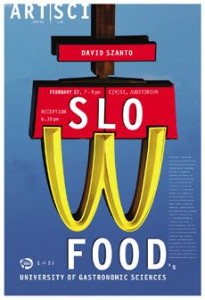 The Slow Food movement bypasses the industrial food conglomerates and seeks to reconnect citizens to the richness of a common life with the neighbors who grow and prepare our food. Slow movements (slow cities, slow travel, slow parenting, slow living & more) are a call for intentionality, an awareness of our mutual interdependence with all people and all creation. They seek to root people in community – where we spend time caring and sharing, talking and doing things for one another.
The Slow Food movement bypasses the industrial food conglomerates and seeks to reconnect citizens to the richness of a common life with the neighbors who grow and prepare our food. Slow movements (slow cities, slow travel, slow parenting, slow living & more) are a call for intentionality, an awareness of our mutual interdependence with all people and all creation. They seek to root people in community – where we spend time caring and sharing, talking and doing things for one another.
Slowness doesn’t require everything be done at a snail’s pace, Honoré tells us. Instead, it seeks to do things well and at the right speed. It’s about “savoring the hours and minutes rather than just counting them.”
So what does the Slow Movement mean for education? It asks us to reimagine what it means to be a community of learners. It requires us to embrace the organic messiness of learning. It requires admitting that a large part of what is happening isn’t good for our children, our teachers, or our communities.
Rather than a top down industrialized and homogenized assembly line, we need a grass roots Slow Education movement that takes into account what real learning looks like and why children really need to learn more slowly, freely and thoroughly.
As Honoré states, “We are doing a great disservice to our children by pushing them so hard to learn things earlier and earlier and by keeping them so busy. They need time and space to slow down, to play, to be children. Across the world, parents, politicians, adults in general are so anxious about children nowadays that we have become too interventionist and too impatient; we don’t allow them enough freedom.”
Education needs to be authentic
As we slow down learning, education has room to become more authentic. Authentic education requires that learning not be based on worksheets, standardized tests, or the myriad of other terrible things we subject children to. It allows children of all ages to engage in real, meaningful work that matters to them and their community. As a result, children gain an authentic purpose and a role in society other than consumer-in-training.
Authentic education also allows students to discover the everyday citizens in their community and how they are working to make it a better place. It provides kids with the opportunity to identify and seek solutions to local problems, reinforcing the idea that they can make a difference. All the while, we are re-educating our communities to see students as authentic, viable, active participants in community life.
Authentic education is also a democratic act. An act in support of justice. It’s about allowing kids the chance to explore social issues and helping them become ethical citizens.
Personalized and Formative
Education must be personalized – responsive to the real needs of each student. This could mean the abolition of grade levels based on age. When education is personalized, it emphasizes student interests, teaches skills using worthwhile content – and most important – shows kids how to tap into their own innate motivation to learn. It puts the onus of learning on those who have the most at stake in school: students.
Personalized learning requires teachers to become co-learners and release their iron grip on the learning process. It requires districts to trust principals, principals to trust teachers, and teachers to trust students. It requires a great deal of conversation about what real learning is and why it matters.
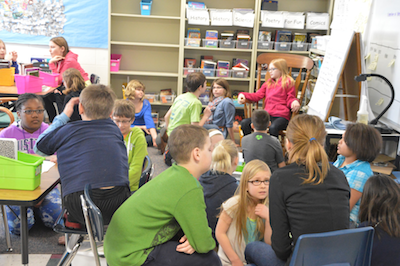 This student-driven approach to learning allows kids to explore what matters to them, to build things that don’t work and to figure out why. It requires them to form opinions and justify them based on solid evidence. And it requires adults who care and can speak carefully and honestly into the lives of kids.
This student-driven approach to learning allows kids to explore what matters to them, to build things that don’t work and to figure out why. It requires them to form opinions and justify them based on solid evidence. And it requires adults who care and can speak carefully and honestly into the lives of kids.
All learning should be formative. We talk a lot about formative and summative assessment. But why do we have summative assessment? To give a mark. To average up the test scores so kids can have grades for college applications. Grading should be abolished. In addition to being an arbitrary tool that we’ve fed an awful lot of power into, marks mean very little. What does 82 mean? Really. I’ve asked students that question. I’ve asked parents and other teachers, as well. No one really knows. Does it mean you don’t know 18% of the stuff? And which 18%. What if it’s the really important 18%?
I once broached the topic of abolishing marks with a senior administrator in my school division. The response was, “Do you know how big that is? Do you know how much work that would take?” Yes, I think so. But is the reason we don’t do what we know is best for our children because it’s too much work? Or is it more the politics?
Formative assessment allows kids to reflect on their learning and figure out how to create better. Why does something work? Why doesn’t it? What did we do well? Where can we improve? It allows for more experimentation and less judgment. It provides feedback that matters to students. Done well, it provides them a voice in the learning process. And it allows me to know, day after day, what my students can do well and where they need to improve. I’ll take that over 82% any day.
It’s true… if we slow down education, kids might learn less. But if we take the time and use it well, they will learn less about the things that matter least, and more about what matters most. Best of all, they will learn how to learn on their own. And then they can learn anything.
Right now, I truly question whether most students are learning anything other than how to “do” school, or that they’re not “academic.” If we get serious about slowing down education, however, we have the possibility of educating kids in a way that helps them to develop into people who are happy, healthy and humane.
How do we build a Slow Education movement?
✓ We abolish the busy, controlling, aggressive, hurried, analytical, stressed, superficial, impatient, quantity-over-quality education environment that prevails today.
✓ We educate parents and communities about the risks of today’s current model, including the drawbacks of “edubusiness.”
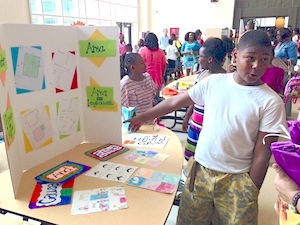 ✓ We create learning environments that are carefully crafted, receptive, still, intuitive, unhurried, patient, reflective, quality-over-quantity and engaging.
✓ We create learning environments that are carefully crafted, receptive, still, intuitive, unhurried, patient, reflective, quality-over-quantity and engaging.
✓ We develop curriculum that has greater depth than breadth.
✓ We make sure our curriculum takes into account local culture and celebrates the uniqueness of our local community.
✓ We don’t isolate skills development but let students grow their skills as they engage with important content.
✓ We construct learning environments that foster questioning, creativity and innovation, such as the maker movement and project/problem based learning.
✓ We find the courage to have serious discussions about abolishing standardized testing, classroom marks and grading, and the use of “birth year” as our primary criterion for sorting students.
✓ We lobby our governments for funds to assure true equality in education for all children.
✓ We discontinue the ranking of teachers and schools.
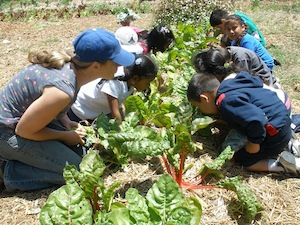 ✓ We replace our egg-carton grades with flexible, personalized learning that takes into account when students are ready to engage in and acquire important skills.
✓ We replace our egg-carton grades with flexible, personalized learning that takes into account when students are ready to engage in and acquire important skills.
✓ We make time for teacher collaboration a top priority.
✓ We expect all classrooms to connect students globally so they can learn from others around the world and apply what they learn in their own communities through meaningful projects and service.
✓ We make student voice and choice an integral part of everyday teaching and learning.
For me the question isn’t who will let us – the question is who will stop us? It’s time to do what is best for students. It’s time to do what’s best for teachers. It’s time for a grass roots movement that comes together to change the tide. Are you ready?
No comments:
Post a Comment